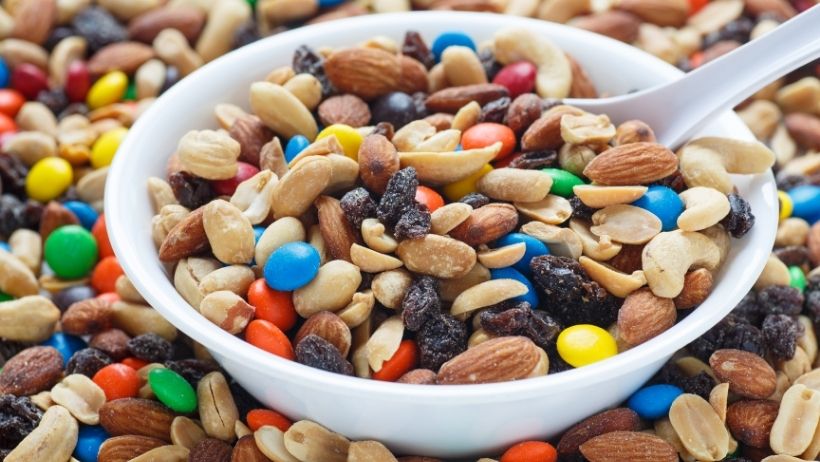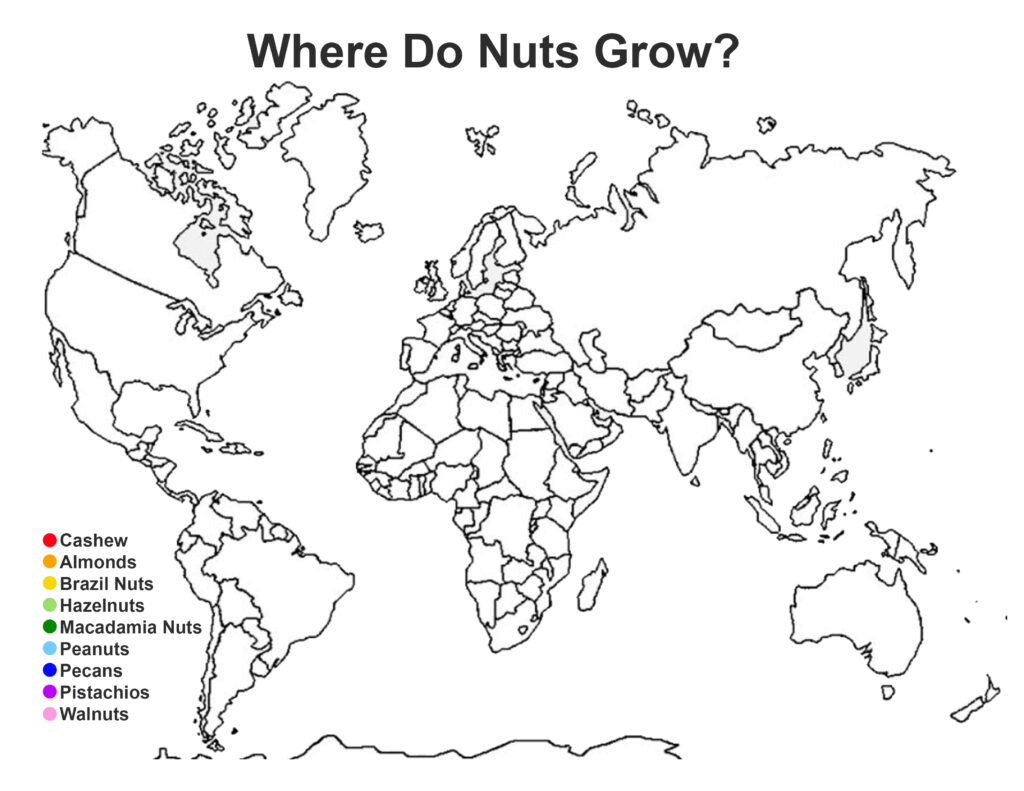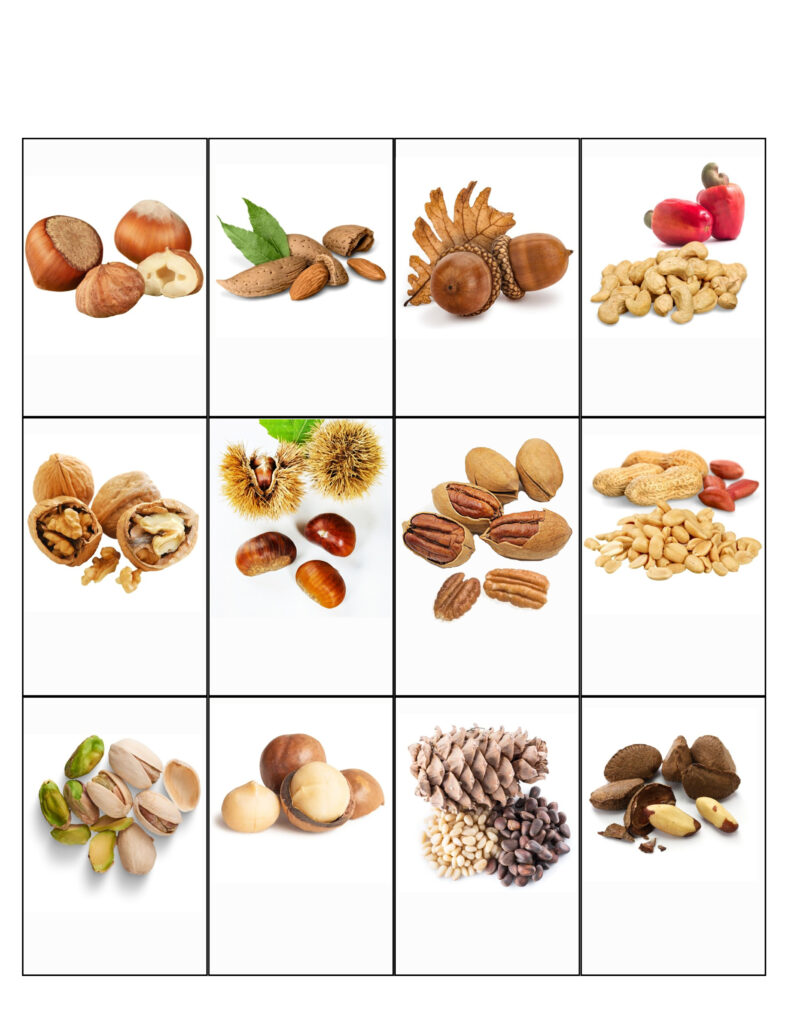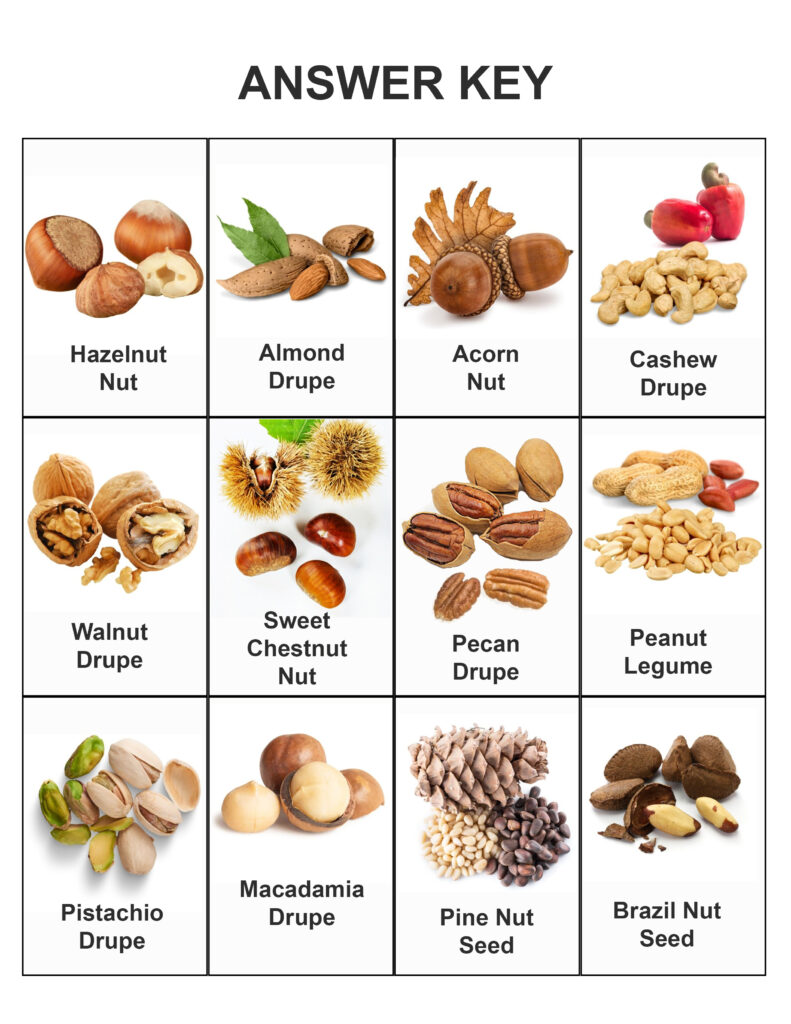
Nut Unit Study and Badge Resources
Nuts are delicious healthy snack packed with fiber, protein, healthy fats, vitamins and minerals. Use our Nut Unit Study to earn your Nuts badge. Other badges you may wish to earn alongside include topics like the Nutrition, Baking, or Farm Equipment badges.
What is a nut?
Many foods that people call “nuts” technically are not in the botanical sense. For example a peanut is actually a legume in the same family as peas and lentils. Almonds are technically “drupes” or stone fruits, not nuts. So what is a nut exactly? A true nut is a fruit that becomes hard and doesn’t split open. A “nut” hidden inside a fleshy covering, like an almond, is not a nut. It’s a drupe, or stone fruit. Edible seeds enclosed in pods are legumes.
The term “nut” is frequently used for a variety of edible seeds even if they are not truly “nuts.” The term “tree nut” for example refers to cashews, almonds, Brazil nuts, hazelnuts, pecans, pistachios and walnuts. While some of these are true nuts and others are drupes, they all cause similar allergic reactions. For the purposes of the rest of the unit study, we will refer to all tree nuts as “nuts.”
To Do: Play “Nut or Not”. Print out 3 copies the picture cards. Shuffle and flip over one at a time taking turns to say the name of the nut and whether it is a nut, seed, legume or drupe. If you are correct, you keep the card. If you are incorrect the card goes to the bottom of the deck. The person with the most cards when the pile is gone wins.
Fulfills preschool, Level 1 and Level 2 requirement #1
How are nuts grown and processed?
Each type of nut is different, but for most tree nuts, the general process of growing and harvesting nuts is similar. All nut farmers must cultivate and plant the seedlings, to grow mature, fruit producing trees, and harvest and collect the nuts.
To Do: Take a field trip to a nut farm. If you are not able to do so in person, take a virtual field trip such as the one below to an Australian almond farm.
Fulfills Level 4 requirement #2
How to properly crack a nut
The shells on various nuts can vary greatly. Learning to crack them safely while still keeping your nut intact can be difficult. Make sure to only crack nuts under the supervision of an adult and to follow all safety guidelines.
To Do: With the help and supervision of an adult, properly crack at least 3 different types of nuts.
Fulfills Level 1 requirement #2
Nut taste test
Just like traditional fruits vary in taste and texture, so do nuts. Just because you like almonds does not mean you like walnuts. Some people like raw nuts while others only like them roasted.
To Do: Taste at least 6 different types of raw nuts. How do they differ is taste, texture or smell? Which did you like and why? Now try those same nuts roasted with salt. Do you like them better?
To Do: Try some spiced nuts, either store bought or homemade. Almonds come in a variety of flavors from BBQ to Sweet Thai Chili. Peanuts might be Wasabi or Chili Lime flavored. Pecans might be Cinnamon Dusted or Hot and Spicy.
To Do: Make your own trail mix by adding items like dried fruit, seeds or dark chocolate pieces to a variety of nuts.
Recipe Ideas:
- Sweet and spicy roasted party nuts by Cookie+Kate
- BBQ seasoned roasted almonds by Delicious by Design
- Spiced pecans by The Food Network
- Rosemary and thyme spiced nuts by A Farm Girl Dabbles
Fulfills preschool requirement #2 and Level 2 requirement #2

Where do nuts grow?
Nuts grow all over world, but each type of nut requires a specific climate and soil. For example almonds require a warmer Mediterranean-like climate. While most almonds are grown in California, they may also be grown in places like Spain, Morocoo, Iran and some southwest Asian countries.
To Do: Print out the world map below. Using the color key, place a colored dot in each country that grows that specific nut. You can use the information found on the Argires Snacks website to fill in your map. In addition to where each nut is grown they also discuss how each nut is grown and harvested as well as a variety of nut trivia and statistics.
Fulfills Level 3 requirement #2 and optional requirement #4

Nuts and Nutrition
Nuts provide a variety of nutritional benefits. For example, according to Healthline:
- Almonds – a good source of healthy fat, protein, fiber, and several vitamins and minerals, but they may also reduce heart disease risk factors like elevated LDL (bad) cholesterol and excess belly fat.
- Pistachios – good source of numerous nutrients, including vitamin B6, which your body needs for nutrient metabolism and immune function. Pistachios also help with inflammation.
- Walnuts – benefit heart health and may reduce several heart disease risk factors, including elevated blood pressure, LDL (bad) cholesterol, and triglyceride levels
- Cashews – good source of several nutrients that are essential to bone health, including protein, vitamin K, magnesium, and manganese
- Pecans – good source of the mineral zinc, which plays an important role in immune function, wound healing, DNA synthesis, and growth and development
- Brazil Nuts – high in a number of vitamins and minerals, including vitamin E and magnesium, a mineral that’s essential for blood sugar and blood pressure regulation, nerve function, and energy production
To Do: It is easy to add nuts to your diet by including them in many recipes. Cook a recipe that includes nuts and understand nutritional benefit of the nut used. Some examples include:
Fulfills optional requirements #9 and #10
Follow our Facebook page for badge of the week posts and other resources. For planning purposes you can see which badges will be featured on our badge of the week calendar. You can also sort and search articles by topic on our main blog page. If you are not already a member, check out our membership pricing page.







